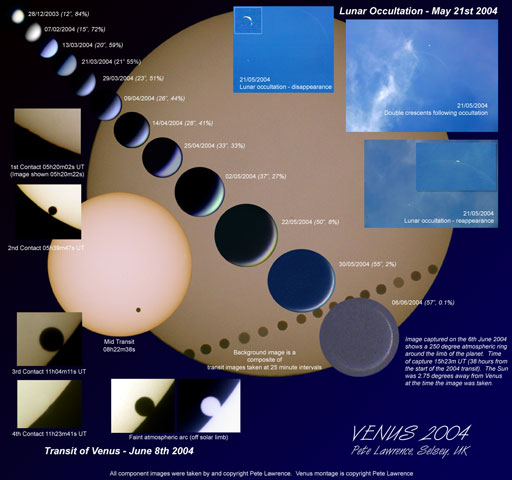Credit & Copyright:
Credit & Copyright: Peter Lawrence
Explanation:
An unusual type of solar eclipse occurred last week.
Usually it is the
Earth's Moon that
eclipses
the Sun.
Last week, for the first time in over 100 years, the planet
Venus took a turn.
Like a solar eclipse by the Moon, the phase of Venus became a continually thinner
crescent as Venus became increasingly
better aligned with the Sun.
Eventually the alignment became perfect and the
phase of Venus dropped to zero.
The dark spot of Venus crossed our parent star.
The situation could technically be labeled a Venusian
annular eclipse with
an extraordinarily large
ring of fire.
From above the
thick cloud tops of Venus,
the Earth appeared in its fullest phase, brighter in the
Venusian sky than even
Mars appeared from Earth last August.
Hours later, as Venus continued in its orbit,
a slight crescent phase appeared again.
The next Venusian solar eclipse will occur in 2012.
Credit & Copyright: Peter Lawrence
1999 2000 2001 2002 2003 2004 2005 2006 2007 2008 2009 2010 2011 2012 2013 2014 2015 2016 2017 2018 2019 2020 2021 2022 2023 2024 2025 |
Yanvar' Fevral' Mart Aprel' Mai Iyun' Iyul' Avgust Sentyabr' Oktyabr' Noyabr' Dekabr' |
NASA Web Site Statements, Warnings, and Disclaimers
NASA Official: Jay Norris. Specific rights apply.
A service of: LHEA at NASA / GSFC
& Michigan Tech. U.
|
Publikacii s klyuchevymi slovami:
Venus - transit - annular solar eclipse - Venera - Prohozhdenie - kol'cevoe zatmenie
Publikacii so slovami: Venus - transit - annular solar eclipse - Venera - Prohozhdenie - kol'cevoe zatmenie | |
Sm. takzhe:
Vse publikacii na tu zhe temu >> | |
